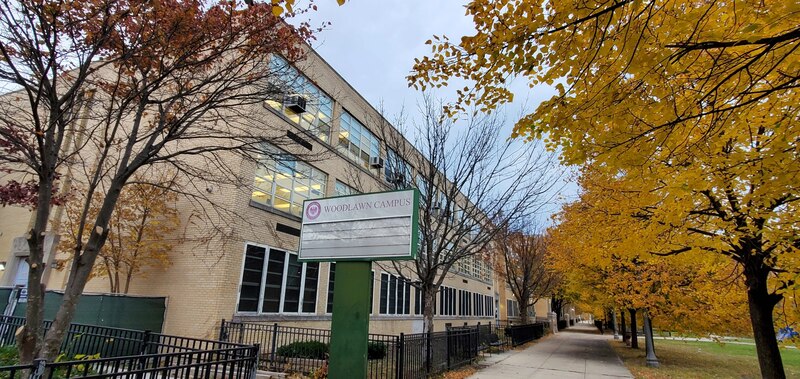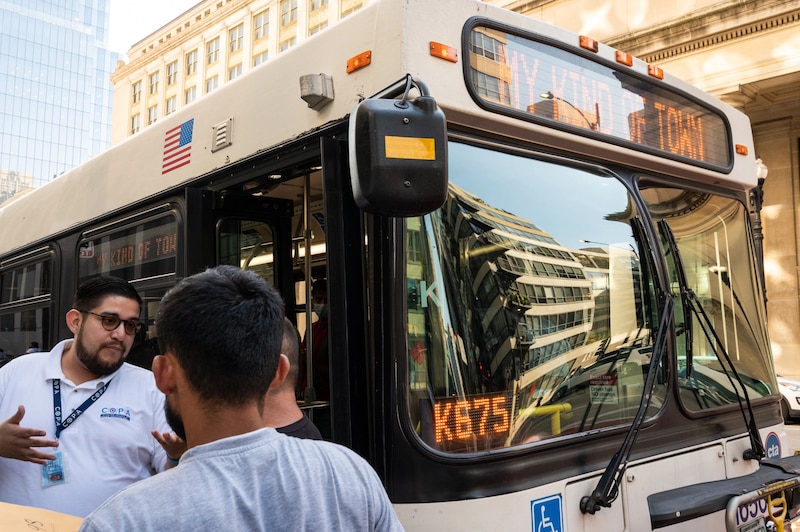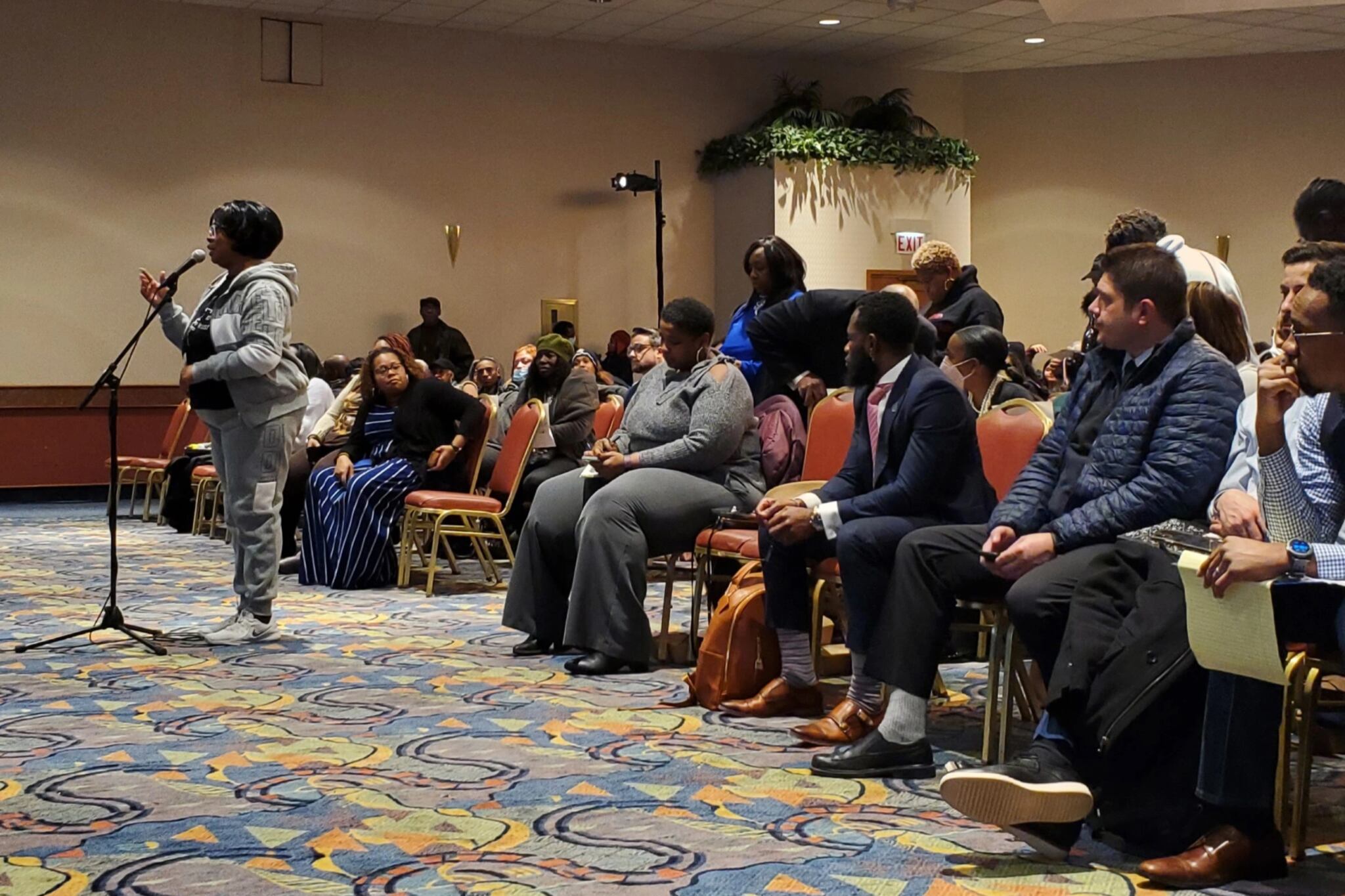After months of back-and-forth, city officials now say they will move 250 migrants into a former Woodlawn school building at the end of January, with more expected over the next two years.
Mayor Lori Lightfoot’s administration has for months planned to house migrants — mostly asylum seekers, according to city officials — at the vacant former home of Wadsworth Elementary School.
Several hundred neighbors were presented Thursday with the city’s latest plan for Wadsworth during a public meeting at Apostolic Church of God.
The city now intends use Wadsworth as a shelter for up to two years. Up to 250 single men and women will move in starting the week of Jan. 23, with more migrants housed at the campus in the coming months. Officials have not yet determined the maximum number of people to be sheltered there.
The city must use Wadsworth to house migrants as the shelter system struggles to keep up with new arrivals every day, said Brandie Knazze, commissioner of the Department of Family and Support Services.
About 5,150 migrants have arrived in Chicago since Aug. 31, when Texas Gov. Greg Abbott, a Republican, began busing them to Democrat-led cities to protest federal immigration policies.
Texas and Colorado — the latter of which is led by a Democratic governor — have since sent more than 100 buses to Chicago, along with 1,500 migrants who arrived in the city separately, Knazze said.
News of the Wadsworth shelter plans was first reported in the fall. The details have changed numerous times since Ald. Jeanette Taylor (20th) said in October she was briefed on housing hundreds of migrants at the former school.
Even as the city spent about $1.6 million and at least 400 work hours preparing the building for use as a shelter, Lightfoot spokesperson Ryan Johnson denied at the time Wadsworth would become a shelter.
Officials changed their tune at a late December community meeting and announced they would move 150 migrants into Wadsworth starting Jan. 6. The about-face “blindsided” Taylor, she said. She also criticized the city’s move to hold the meeting when many people were out for the holidays.
City leaders delayed the move-in date last week to convene community meetings and develop a safety plan for the Wadsworth campus after pushback from neighbors.
As city staffers discussed timeframes, public safety, site security, and other issues this week, Woodlawn residents overwhelmingly blasted the city for sharing details only once it was a “done deal” that Wadsworth would become a shelter.

About 50 neighbors variously described Thursday’s public input session following an outline of the city’s latest plans as a “slap in the face,” “ingenuine,” “condescending,” and “last-minute.”
A 26-day turnaround from initial notice to a move-in date is “extremely short,” considering the shelter could be active for two years, resident Stephanie Crockett-McLean said.
Crockett-McLean and other residents also took issue with the city’s renovations for its shelter plans after letting the property sit idle for years. The building on Oct. 14 underwent its first city inspection since 2017, the year the University of Chicago’s charter school moved out.
Officials shared more details about the Wadsworth plan at Thursday’s meeting than they had previously, which was positive, Apostolic Church pastor Byron Brazier said.
But overall, “the city has not listened to us as [it] should,” and Woodlawn residents must be the ones leading policy decisions in the neighborhood, Brazier said.
The Wadsworth shelter “is temporary, and we need to make sure it’s temporary,” Brazier said. “… We as a community will be planning for our community.”
Knazze apologized to attendees for the city’s handling of the shelter rollout.
“I know we didn’t get the ask right the first time we came before you, and for that, I am truly sorry and I apologize,” she said. “That oversight was a huge mistake, and it caused a lot of confusion, and I’m sorry.”
Moving forward, city officials will provide updates on the Wadsworth shelter to Taylor’s office every two weeks; hold monthly community meetings for the next three months, then hold meetings every other month; and invite two Woodlawn residents to sit on a citywide advisory council around the migrants’ arrival, Knazze said.
Representatives from Taylor’s office, police and state officials met privately Monday to discuss a safety strategy for the shelter, which was also announced Thursday.
The site will receive “special attention” from police, 3rd District Cmdr. Roderick Watson said Thursday. Officers will visit the site on each watch and employ community policing strategies to address any ongoing issues and trends, Watson said.
Security contractors will also be onsite around the clock, with officers stationed at every door, Knazze said.
The migrants, who are checked against national security and criminal databases upon arriving at the border, will have an 11 p.m. curfew and will be required to sign in and out of the building, officials said.
Parks and walking paths on the campus will remain open to the public, and police surveillance cameras will be installed near the school, Knazze said. The safety plan is “fluid” and can be adjusted as needed, Watson said.

Amid the chaos caused by the governors’ decisions to bus migrants to Chicago, residents have expressed pushback — and sometimes, explicit xenophobia — around housing the overwhelmingly Latino migrants in their communities.
At a protest in Woodlawn, one resident said, “there’s plenty of room in Little Village for their people,” according to the Tribune.
Taylor bashed city officials for throwing “a grenade into our community” with the Wadsworth shelter plans, but she urged Woodlawn residents not to view the migrants as their opponents.
“This is not about [migrants] versus us. It is not, because at the end of the day, the system has mistreated all of us,” Taylor said. “This is about making sure that this situation that was pushed upon us is safe for everybody.”
The city is not taking away funds from services for people experiencing homelessness to pay for its effort to shelter migrants, officials said.
Woodlawn residents have called for Mayor Lori Lightfoot to attend community meetings about the Wadsworth shelter. The mayor did not attend Thursday.
At a news conference earlier that day — hours before her family and support services commissioner apologized — Lightfoot defended her administration’s community outreach around the Wadsworth plans.
“We are engaged. I personally have talked multiple times with the alderman, I’ve talked with Dr. Brazier,” Lightfoot said. “Our team has been engaging with other stakeholders there for a couple of weeks now, since we made the decision that was necessary for us to open up Wadsworth school.”
“I would not say that there’s any lack of transparency — quite the opposite,” she said.
This story was originally published by Block Club Chicago.







